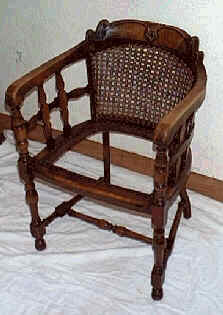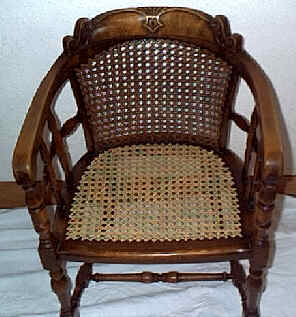|
 |
|
(pic.1) |
. (pic.2) |
FURNITURE
RESTORATION
HOME PAGE HOW TO
CONTACT MEL
WOODWORK REPAIR STRIPPING
& RE-FINISHING
RE-SEATING CHAIRS
THE RE-CANING OF A CHAIR SEAT
(pic.1) You can see the damaged chair seat
that needs restoring.
(pic.2) The first step is to remove all the damaged canework and any old pegs which were used to secure the cane in the seat rail holes.
|
 |
|
(pic.1) |
. (pic.2) |
(pic.3) Next the first rows of Doublings are
worked into the chair seat.
(pic.4) Then the first rows of Settings are added at 90 degrees to the Doublings
 |
 |
|
(pic.3) |
(pic.4) |
(pic.5) Next a second set of Doublings are added
directly over the first Settings and Doublings. Once this is
completed more Settings are woven to form squares.
(pic.6) After this the first set of Crossings are woven diagonally between the Doublings and Settings.
 |
 |
|
(pic.5) |
(pic.6) |
(pic.7) Then the weaving is completed by adding a
second set of Crossings in the opposite direction to the first.
This completes the standard six weave, the holes are then pegged
and any loose ends secured.
(pic.8) Finally, the new canework is coloured to match the original.
 |
 |
|
(pic.7) |
(pic.8) |
FURNITURE
RESTORATION
HOME PAGE HOW TO
CONTACT MEL
WOODWORK REPAIR STRIPPING
& RE-FINISHING
RE-SEATING
CHAIRS